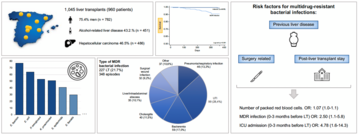Martin R, Martínez L, Carvalho Á,..., Graus J, Albillos A. Multidrug-resistant bacterial infections after liver transplantation: prevalence, impact, and risk factors
J Hepatol. 2024
"Multidrug-resistant bacterial infections increase mortaliy rates after liver transplantation. This multicenter study reveals the associated risk factors and the most prevalent bacterial isolations, providing valuable insights for the development of prophylactic and empirical antibiotic strategies. " - Dr. R. Martín
Summary:
Infections caused by multidrug-resistant bacteria (MDRB) are increasing worldwide and are associated with worsened prognosis and elevated costs. This study analyzes the incidence, burden, and risk factors associated with MDRB infections after liver transplantation (LT). We performed a multicenter cohort study that included 1,045 LT procedures (960 patients). Risk factors related to the pre-LT disease, the surgical procedure, and the postoperative hospital stay were analyzed. Bacterial infections occurred in 432 patients (41.3%) being the respiratory infections followed by urinary tract infections the most common ones. MDRB were isolated in 227 LT cases (21.7%) (348 episodes). Enterococcus faecium was isolated in 22.1% of the MDRB cultures. In multivariate analysis, previous intensive care unit admission (0-3 months before LT), previous MDRB infections (0-3 months before LT), and an increasing number of packed red blood cell units transfused during surgery, were identified as independent predictors of MDRB infections. Mortality at 30, 90, 180, and 365 days was significantly higher in patients with MDRB isolates.
Why do you highlight this publication?
To date, the impact and risk factors associated with MDRB infections after liver transplantation had not been fully explored. Our study was conducted in a large cohort of patients from 9 transplant centers across Spain. It shows that MDRB infectiosn have a deep impact on morbidity and mortality, and unveils the most frecuent bacterial isolations. Data obtained from this collaborative work may guide future strategies aimed at improving prophylaxis, early identification, and empirical antibiotic treatment after liver transplantation.
Publication commented by:
Dr. R. Martín
Gastroenterology and Hepatology Department
Liver And Digestive Diseases Group
IRYCIS



